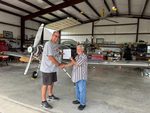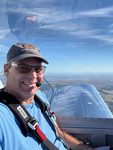Taxi Testing
I taxi tested my plane today. First time it moved under its own power which was gratifying. My goal was to get it started, get down to the runway and complete my checks, then return as quickly as possible so as not to unnecessarily run the engine and interfere with the break-in process. I did it in the morning when it was cool. A pilot neighbor and my wife in a golf cart with a hand-held VHF radio took video and could let me know of any problems. Being fortunate to live at an airpark, I have an approximately 1500' grass taxiway connecting to a 3000' asphalt runway. Initial taxiing on the grass seemed fine. There are several bumpy spots that I proceeded slowly on. I also had my canopy fully closed and latched to avoid putting unnecessary stresses on it. Once on the runway aircraft tracking, steering, and braking all seemed fine. I bedded in the brakes by dragging them with power on the engine to glaze the pads. Video showed that both brakes started lightly smoking at the same time which ceased when I stopped. I believe this smoke was the black paint that Grove had applies to my discs burning off with from the heat. I shut down per Grove guidance to let them cool for 10 minutes. They seemed hot but not unduly so and quickly cooled. After 15 minutes I restarted using the Lycoming hot start technique and it fired right up. Then did a full power runup holding the brakes and they held which was good. I then taxied back to my hanger and shut down. I had done an idle speed adjustment and full power governor check the day prior with the plane chocked and tied down. This yielded 2650 RPM, 50 RPM below redline and a 700 RPM idle. I elected not to adjust the governor at the time because I knew performance would still be excellent. My big concern was any kind of overspeed situation. Even with aft stick the tail rose at full power which caught my attention. 215 HP is a lot of power on a 1700 lb. airplane. After getting the plane back in the hanger I inspected the whole plane, especially the wheel and brake area and pulled the cowling. No discrepancies were found. I also jacked up each wheel to check brake drag which I thought was initially excessive. Prior to bedding in the brakes when I slung each wheel forcefully it would turn approximately 180 degrees before stopping along with some noise. All 4 pedal were in the fully retracted position. With the brake calipers loose, the wheels spun freely so I knew it wasn't an axle nut that was too tight. After bedding in the brakes and burning off the paint the wheels now turn approximately 1.5 turns before stopping and are silent. A definite improvement. It's something I will keep an eye on. My concern is excessive heat buildup. Nothing left to do but fly it. To that end I had traveled to Lincoln, IL a few days prior to get 6.7 hours of dual in an RV-14 and its CFI owner over 3 flights. It was excellent training. My insurance carrier required 5 hours minimum, but I'd have done it even if insurance hadn't required it. Just seemed like a prudent thing to do given all the time and money I've invested on this plane. I had a previous taildragger endorsement but hadn't flown one since 2006.
This post is from Scott's RV-14 Build

